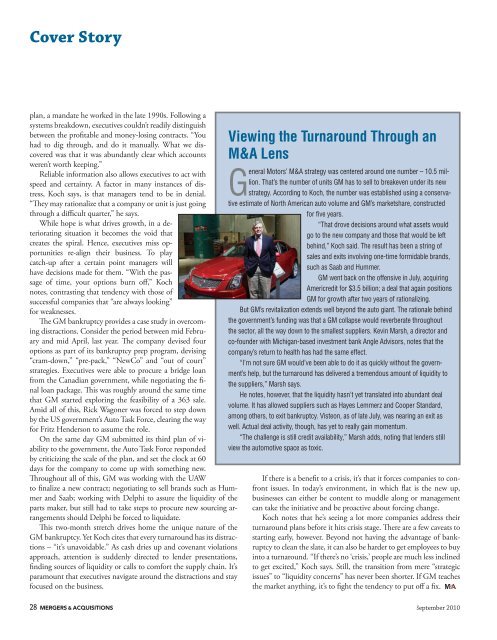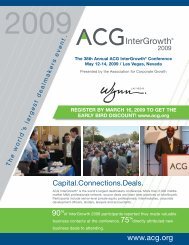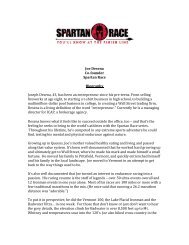September 2010 - Association for Corporate Growth
September 2010 - Association for Corporate Growth
September 2010 - Association for Corporate Growth
Create successful ePaper yourself
Turn your PDF publications into a flip-book with our unique Google optimized e-Paper software.
Cover Story<br />
plan, a mandate he worked in the late 1990s. Following a<br />
systems breakdown, executives couldn’t readily distinguish<br />
between the profitable and money-losing contracts. “You<br />
had to dig through, and do it manually. What we discovered<br />
was that it was abundantly clear which accounts<br />
weren’t worth keeping.”<br />
Reliable in<strong>for</strong>mation also allows executives to act with<br />
speed and certainty. A factor in many instances of distress,<br />
Koch says, is that managers tend to be in denial.<br />
“They may rationalize that a company or unit is just going<br />
through a difficult quarter,” he says.<br />
While hope is what drives growth, in a deteriorating<br />
situation it becomes the void that<br />
creates the spiral. Hence, executives miss opportunities<br />
re-align their business. To play<br />
catch-up after a certain point managers will<br />
have decisions made <strong>for</strong> them. “With the passage<br />
of time, your options burn off,” Koch<br />
notes, contrasting that tendency with those of<br />
successful companies that “are always looking”<br />
<strong>for</strong> weaknesses.<br />
The GM bankruptcy provides a case study in overcoming<br />
distractions. Consider the period between mid February<br />
and mid April, last year. The company devised four<br />
options as part of its bankruptcy prep program, devising<br />
“cram-down,” “pre-pack,” “NewCo” and “out of court”<br />
strategies. Executives were able to procure a bridge loan<br />
from the Canadian government, while negotiating the final<br />
loan package. This was roughly around the same time<br />
that GM started exploring the feasibility of a 363 sale.<br />
Amid all of this, Rick Wagoner was <strong>for</strong>ced to step down<br />
by the US government’s Auto Task Force, clearing the way<br />
<strong>for</strong> Fritz Henderson to assume the role.<br />
On the same day GM submitted its third plan of viability<br />
to the government, the Auto Task Force responded<br />
by criticizing the scale of the plan, and set the clock at 60<br />
days <strong>for</strong> the company to come up with something new.<br />
Throughout all of this, GM was working with the UAW<br />
to finalize a new contract; negotiating to sell brands such as Hummer<br />
and Saab; working with Delphi to assure the liquidity of the<br />
parts maker, but still had to take steps to procure new sourcing arrangements<br />
should Delphi be <strong>for</strong>ced to liquidate.<br />
This two-month stretch drives home the unique nature of the<br />
GM bankruptcy. Yet Koch cites that every turnaround has its distractions<br />
– “it’s unavoidable.” As cash dries up and covenant violations<br />
approach, attention is suddenly directed to lender presentations,<br />
finding sources of liquidity or calls to com<strong>for</strong>t the supply chain. It’s<br />
paramount that executives navigate around the distractions and stay<br />
focused on the business.<br />
Viewing the Turnaround Through an<br />
M&A Lens<br />
General Motors’ M&A strategy was centered around one number – 10.5 million.<br />
That’s the number of units GM has to sell to breakeven under its new<br />
strategy. According to Koch, the number was established using a conservative<br />
estimate of North American auto volume and GM’s marketshare, constructed<br />
<strong>for</strong> five years.<br />
“That drove decisions around what assets would<br />
go to the new company and those that would be left<br />
behind,” Koch said. The result has been a string of<br />
sales and exits involving one-time <strong>for</strong>midable brands,<br />
such as Saab and Hummer.<br />
GM went back on the offensive in July, acquiring<br />
Americredit <strong>for</strong> $3.5 billion; a deal that again positions<br />
GM <strong>for</strong> growth after two years of rationalizing.<br />
But GM’s revitalization extends well beyond the auto giant. The rationale behind<br />
the government’s funding was that a GM collapse would reverberate throughout<br />
the sector, all the way down to the smallest suppliers. Kevin Marsh, a director and<br />
co-founder with Michigan-based investment bank Angle Advisors, notes that the<br />
company’s return to health has had the same effect.<br />
“I’m not sure GM would’ve been able to do it as quickly without the government’s<br />
help, but the turnaround has delivered a tremendous amount of liquidity to<br />
the suppliers,” Marsh says.<br />
He notes, however, that the liquidity hasn’t yet translated into abundant deal<br />
volume. It has allowed suppliers such as Hayes Lemmerz and Cooper Standard,<br />
among others, to exit bankruptcy. Visteon, as of late July, was nearing an exit as<br />
well. Actual deal activity, though, has yet to really gain momentum.<br />
“The challenge is still credit availability,” Marsh adds, noting that lenders still<br />
view the automotive space as toxic.<br />
If there is a benefit to a crisis, it’s that it <strong>for</strong>ces companies to confront<br />
issues. In today’s environment, in which flat is the new up,<br />
businesses can either be content to muddle along or management<br />
can take the initiative and be proactive about <strong>for</strong>cing change.<br />
Koch notes that he’s seeing a lot more companies address their<br />
turnaround plans be<strong>for</strong>e it hits crisis stage. There are a few caveats to<br />
starting early, however. Beyond not having the advantage of bankruptcy<br />
to clean the slate, it can also be harder to get employees to buy<br />
into a turnaround. “If there’s no ‘crisis,’ people are much less inclined<br />
to get excited,” Koch says. Still, the transition from mere “strategic<br />
issues” to “liquidity concerns” has never been shorter. If GM teaches<br />
the market anything, it’s to fight the tendency to put off a fix.<br />
28 MERGERS & ACQUISITIONS <strong>September</strong> <strong>2010</strong>

















